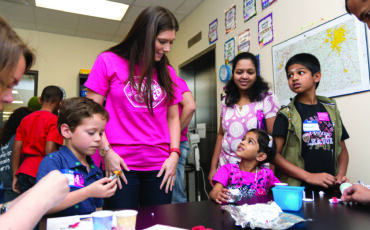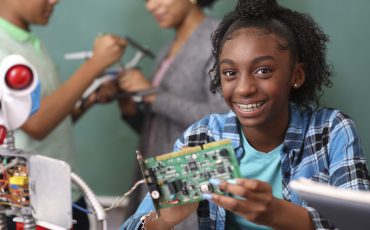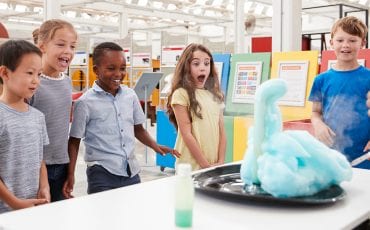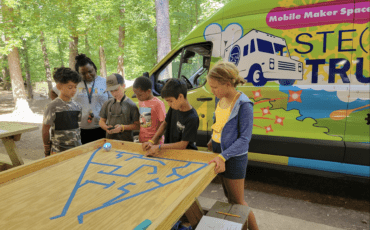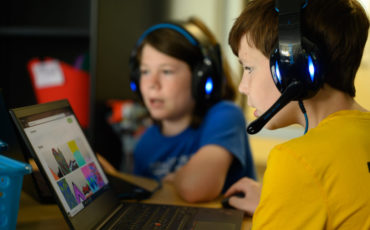Every Day STEAM Is at Play
Every day, in so many ways, you’re using STEAM; you just might not realize it! From traveling to school to enjoying the spring weather to watching favorite TV shows, STEAM is all around us. Explore these 15 activities your family already does to help uncover the importance of STEAM.
Table of Contents
Spotting a Mural
Public art is so beautiful! Art is often used to depict a message in a more colorful way compared to sentences and statements. The next time you’re out and about, see what murals you can spot. What colors did the artist use? Did she use any words to convey her message? What do you think the piece means? If you were to design a mural in your neighborhood, what would it look like? Why?
Riding a Bike
The way you zip around on a bike showcases the energy of motion, whether you’re biking in the yard or on a trail. The power your body produces is kinetic energy, which moves the bike forward. The technology changes as you age and get better at biking—remind your child of how he moved from a tricycle to a bicycle. The bike is a deceptively simple machine; discuss how it needs to look, hold weight and move to get you from point A to point B. Talk to your kids about how the energy changes if you’re going up or down a hill.
Riding in the Car
Often, we’re zooming from one place to the next and not thinking about the piece of technology that’s able to get us there efficiently. Ask your child why he thinks traveling by car is faster than riding a bike. Rather than using human-powered energy, cars use chemical energy in gasoline or electrical energy in a battery. Pop your car’s hood to show him the pieces of technology in the engine. Head out for a drive and think about the other technology needed to keep everyone safe: seat belts, traffic lights, signs for pedestrians. Look at the other cars on the road. If he needed to buy a new vehicle, what model and color would he like?
Counting Your Pennies
Every time you walk the aisles of the grocery store, you’re using math to figure out the best deals. Before heading to the store with your child, create a budget. Have her help you identify the bills and coins you have. Discuss how you can stay within your budget. Compare prices and weight of items. Is it cheaper to buy the generic brand of cereal? Which is a better price: $3 for a 5-oz. jar of pickles or $5 for a 10-oz. jar? Depending on your child’s age, you might even talk about marketing. What colors do you see the most often on packages? Which product’s branding do you like better and why?
Building
All the buildings and structures you see have been designed for a certain purpose. Your child probably owns a ton of building toys, but he might not have connected it to engineering before. Experiment with blocks, LEGOs or Lincoln Logs to create unique structures. Can your child build something that will hold the weight of one of his other toys? What about a book? You can keep recyclable materials, such as cardboard boxes, to build and decorate a playhouse he can use.
Looking Up at the Sky
From clouds to constellations and precipitation to sunshine, there is so much to see and explore when you look at the sky. One clear night, go stargazing in your backyard. Astronomy is the science of studying celestial objects and phenomena, which includes the sun, moon, planets and stars. What constellations can your child spot? If you have a few clear nights where you can spot the moon, pay attention to its phases, and track them in a notebook. During the day, talk about what the clouds look like and how they impact the weather.
Checking the Weather
Spring weather can mean rain showers, warmer weather and sunny skies—sometimes, all in the same day! Meteorology is the scientific study of the day-to-day state of the Earth’s atmosphere, and meteorologists forecast the weather. Watch a weather forecast one morning and discuss what technology the meteorologists must use to make the forecast, as well as what technology they use to send the information to the viewer. On a rainy day, use a stopwatch to check the time between seeing lightning and hearing thunder; for every five seconds, the storm is about a mile away. Maybe after a storm, you spot a rainbow—how did that happen?
Flying a Kite
Let’s go fly a kite! This simple aircraft reacts against the air to create lift and is a fun experiment and arts project. Start by constructing the kite, and experiment with different shapes. You often see diamond-shaped kites, but what happens if you build a circle? A triangle? What happens if you leave off a tail? Use artistic skills to decorate before heading to a nearby park. Try to fly the various shapes to see which ones work the best. What’s the best weather for getting the kite off of the ground?
Going for a Walk
Being outdoors can encourage your child to think about the natural sciences, as well as technical innovations. If you’re taking a walk around the neighborhood or a nearby park, take the time to pay attention. Encourage your child to look around and ask questions. What is growing in the crack on the sidewalk? Are you starting to spot spring blooms? How is that insect different from this one? At a park, dig in the sandbox, watch birds, view the skaters at the skatepark, and play on the playground. Do the skaters move faster based on what they’re using? What is holding up the slide? How do swings move?
Listening to Music
Music is a great way to connect to the arts, as we all love a great playlist that speaks to our emotions or encourages us to move. Give your child the opportunity to explore how to make music, whether that’s by banging on pots and pans or with a musical toy. You can also discuss sound waves and how they travel through different mediums. Explore the technology; does music sound different on the radio vs. when you’re using Spotify? If you’ve kept all your equipment, you can also show her the old ways of listening to music with a CD, a tape or a vinyl.
Baking
Stir up crazy science in the kitchen by cooking or baking together. Double or halve his favorite recipe for supper to practice measuring, equivalent fractions and conversions. Find out what ingredients do. What happens if you leave baking soda out of bread dough? Look up how to make ice cream in a bag or butter in a jar. Bake cake or cookies and give him free reign to decorate.
Logging onto the Computer
Too much screen time is often vilified, but especially if your kids are older, it’s a part of life, so creating healthy habits is key. Teach her the right way to use the computer and talk about the ways in which this technology has made our lives better, as well as any drawbacks. Get her started coding with an online tool or after-school lessons. If she loves video games, encourage her to try making her own with programs like Drawn to Life. If you have a smart device with Alexa or Siri capabilities, ask her how she thinks it works. How does it link to your smart oven or refrigerator?
Gardening
Get your hands dirty with a garden for veggies and herbs. Draw a diagram of where your garden will be and its size. Plants need different amounts of space, sunlight, soil and water; will this change your child’s design? Start seedlings from vegetable seeds or trimmings. Have her decorate pots, labels or painted rocks for identifiers. Study the growth patterns of the plants you use and what happens to them depending on the weather. What tools or technology does a farm need to cultivate food for more people? If you don’t have room for an outdoor garden, use the kitchen windowsill for potted herb plants.
Cleaning
From cleaners to surfaces to technology, keeping a tidy house is a STEAM activity. Explain to kids how soap repels germs, and hypothesize why different cleaners are needed for different surfaces, such as the stainless steel refrigerator vs. glass windows. Experiment with household items to find the right cleaner for the kitchen, bathrooms and furniture. Some materials to use are vinegar, baking soda, water, olive oil and lemon juice. Discuss the way electricity has changed cleaning. How do you think people used to wash their clothes before washing machines? If you have a robot vacuum cleaner, discuss how you think it works and can sense messes.
Playing a Sport
Sports are an excellent way to explore STEAM concepts. Learn the physics behind hitting a fastball with a bat or discuss how a gymnast balances on a beam. Play around at the tennis court to see what happens if you try to hit a baseball or golf ball with a racquet. Evaluate the clothes needed: why do baseball and softball players wear cleats, why are roller skates and ice skates different? At a game, explore math and the probability a player will make a certain goal. If you’re interested in a curriculum, check out stemsports.com.



